On October 8, 2015, Mark Hayden, bylaw officer for the town of Ladysmith, British Columbia, chartered a boat. For five minutes, he motored along the arbutus-lined banks of Vancouver Island until he reached a stretch of the coast officially called District Lot 651. Locals know it as the Dogpatch, and, for years, it’s been driving the small island town mad.
Ladysmith has a low crime rate, an aging population, and a picturesque downtown that’s cut off from the water. Getting to the Dogpatch involves crossing the Trans-Canada Highway and the overgrown railroad tracks, and descending down a forested path to reach the waterfront—it’s literally on the wrong side of the tracks. According to many townspeople, the boats anchored there are “eyesores” that leak oil. The people who live on board are “water squatters” who clog the harbour, sap tourism dollars, and bring a slew of unseemly problems to otherwise idyllic Ladysmith. Rumours swirl of thieves and drug dealers coming to shore at night to pillage and ply their trade. The Patch is one of the last at-anchor communities in BC, and the town is trying to clean out the squat for good. Its residents, a mix of adventurers, rebels, and societal misfits, live off the grid and don’t pay for moorage. The Dogpatchers know what people say, but to them, it’s just mudslinging. They’ve endured far worse.
As Hayden entered the calmer waters, he wove in and around the fifty-eight anchored boats. Some showed signs of life: a curl of smoke drifting from a chimney, the drone of a generator, kayaks strung to stern. But many looked rundown, with rust and algae stains rimming the hulls, battered tarps pulled across their decks, old bicycles and paint cans piled on board. Others looked long abandoned. The officer taped a slip of paper to every vessel. The infraction: violating the town’s zoning bylaw that limits anchoring on the stretch to seven days. If the Dogpatchers stayed past November 15, the notice warned, the town could remove their property and force them out.
When the officer arrived at Daniel Inkersell’s boathouse on the south side of the Patch, Inkersell was inside drinking a cup of coffee and repairing the engine of his classic Chris-Craft yacht. Inkersell is a handsome, cheeky man who “likes to have a time,” as he says in his bouncy Nova Scotian accent. A typical twenty-six-year-old is in the city: dating, drinking, building a life. But Inkersell has tied his immediate future to a crumbling pillar in the Patch. In February 2014, he bought Sojourn for $8,000 with money he earned planting trees, picking grapes, fighting fires, and ruining his back in the Interior of BC. An affinity with wooden boats runs deep in the Inkersell family. His dad once owned a sleek, all-wood Chris-Craft similar to Sojourn. His grandfather, a wooden-boat surveyor, dismissed any vessel made of fibreglass as “Tupperware.”
His plan was to refurbish the yacht himself and upsell her to a Chris-Craft fan, but for the last year and a half, he’d been struggling to find a place to repair her. He’d bounced between a nearby work yard and the Dogpatch, between sleeping in his truck and living at anchor, between finding an indoor space to varnish and rolling out in the rain. He had been living in the Dogpatch full-time for two months, finally making progress on Sojourn’s engine, when the bylaw officer pulled up with a sputter.
Inkersell, keeping it professional, asked for more details about the notice and for the names of all the people aboard Hayden’s boat: an RCMP constable, a town parks employee, and the driver. As the entourage motored away, Inkersell considered his options. Reaching a compromise between the town and the Dogpatch might be easier than hauling up anchor. If he moved, this would happen all over again somewhere new.
In the following weeks, Inkersell motored his skiff from boat to boat, collecting signatures on a letter to Ladysmith’s mayor. Communication in the Patch is, well, patchy. The wireless reception is steady, but many of the dozen people who live there don’t have cellphones or email accounts. News gets spread from ship to ship or ship to shore, the surface of the water acting as a natural megaphone.
Inkersell collected thirty-five signatures from Dogpatchers, some full-time, some part-time, some of whom moored a recreational boat, and others who lived at the nearby marina and spent time in the Patch. Reluctantly, he signed the letter as chairperson of the newly formed Ladysmith Harbour Community. Not long after he mailed it to town hall, Dogpatchers who owned cellphones began to pass him media requests when they crossed paths. Inkersell decided it was time to buy a phone himself.
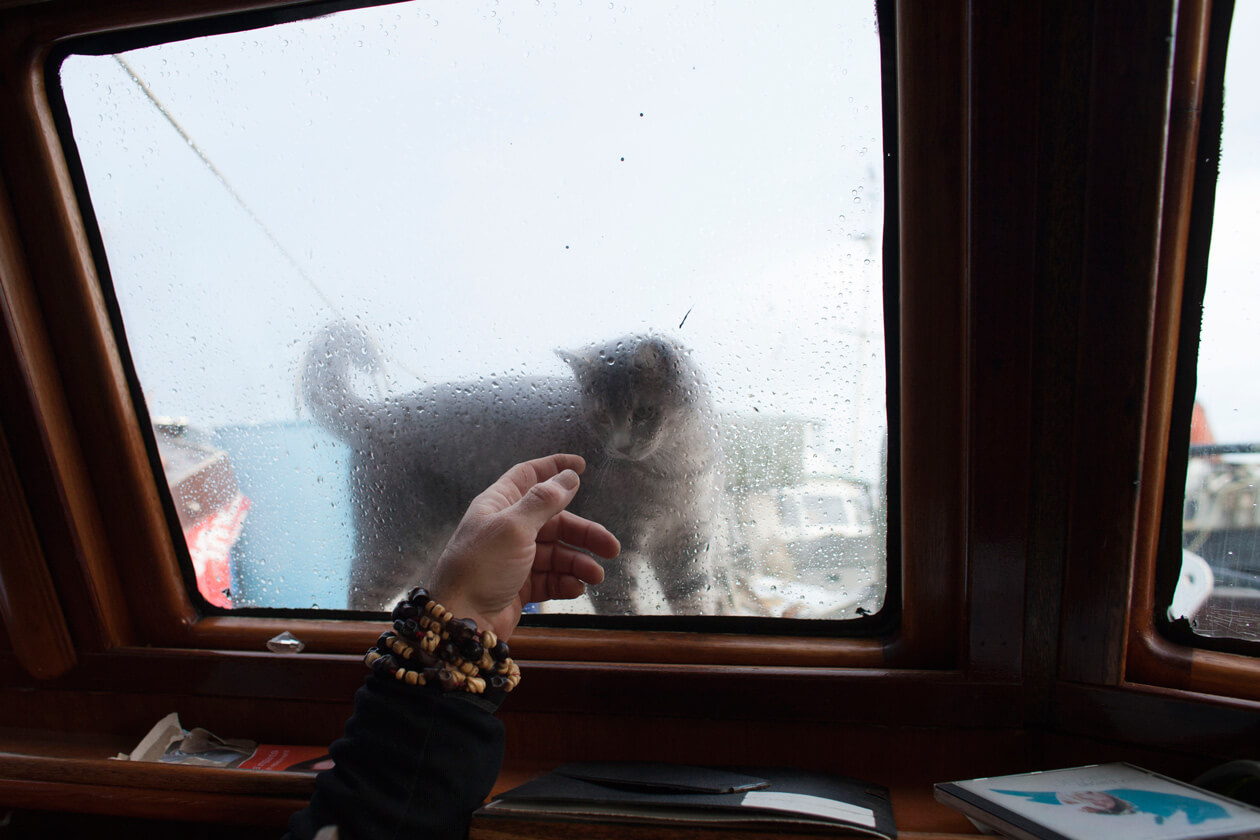
In the 1930s, the coal mine near Ladysmith shut down, putting an end to coal washing in the town’s harbour. A log-sorting operation moved in next, and, in 1985, it closed down, too. Since then, the waterfront has sat undeveloped and the sea life has crept back in: writhing nudibranchs, purple starfish, grey crabs. It’s also become a place where abandoned boats are left to rot.
Transport Canada took an inventory two years ago of problem vessels across BC waterways. With forty-five boats, the Dogpatch had the most by far. Vince Huard, a Patch resident, estimates that there are hundreds more sunk beneath the surface, jettisoned by nearby marinas or neglectful owners, farting up fuel and that distinctive gasoline sheen. “The Dogpatch is like this big red dot on everyone’s map,” he says of the wrecks. Before he took his current job as a fisherman, Huard worked for a local business that disposed of derelict boats. That’s how he found the one he now calls home.
Four years ago or so, Huard left a nearby marina to live in the Dogpatch. Time is slippery here. Certainly, he arrived before the Dogpatch grew up and a group of regulars began to call this place home. “We all kinda forget the day. And I don’t have a mind for dates,” he says. The community evolved at an infinitesimal pace. Sometime in the late ’90s, the first resident of the Dogpatch, a veteran named Paul Coop, arrived, and more soon followed, realizing they could live on the same water as the nearby marina but for free. As one boat left, the next took its place. After a while, people started to stay. They had to haul their own water and fuel, but that suited the type who dropped anchor here just fine: pensioners, welfare and disability recipients, sailors, boatyard workers, people with more time than money and a commitment to life outside the mainstream.
In 2008, the province made an attempt to clear out the area by hauling away docks and equipment unannounced. (The event still haunts a few Dogpatchers who came home to find their few possessions missing.) By most accounts, the Patch has cleaned up since that first sweep. Some of the troublemakers moved along, and a relative peace took root. Then, last summer, the fires started.
Last July, a boathouse inexplicably went up in flames the day before a town rally to oust the most notorious vessel in the Patch: an abandoned 108-foot trawler called Viki Lyne II with 13,000 litres of oil in her guts. Two hundred townspeople gathered on the beach and on the water, in powerboats and kayaks, waving hand-printed signs begging Transport Canada to remove Viki Lyne II before she burst. A month earlier, a sailboat went down, leaving a slick of oil and children’s toys bobbing on the surface. Later that summer, two more boats caught fire—one burned down to the waterline, and the other was left to drift ashore. In the Ladysmith Chronicle newspaper, the RCMP wondered whether vigilante justice was taking root. Town gossip labelled the Patchers junkies and drug dealers who stole from law-abiding boats and ruined the harbour for everyone else.
Many in Ladysmith feel sympathetic to the Dogpatchers because of the poverty, mental illness, and addiction that some of them face. Some even admire their tenacity: “I personally consider most of the live-aboards to be the stewards of the Dogpatch,” read a letter in Take 5 magazine. “And I say: Let them stay.” But the town definitely wants that trawler gone. “The liability is tremendous,” says Rod Smith, the managing director of the Ladysmith Maritime Society docks next to the Patch, where about twenty people pay to live on board boats. “The suspicion is that the only thing holding the hull together is the marine growth.” According to a Coast Guard–commissioned survey, the sinking of Viki Lyne II is “imminent,” but people in the Patch vociferously deny that. Look at the spray paint on Viki Lyne’s hull marking the waterline, they say. The water hasn’t moved, so how can she be sinking?
If the 13,000 litres of oil inside Viki Lyne II were to break free, the spill could spread to four nearby oyster farms, to First Nations land, and to the newly renovated Ladysmith Maritime Society docks, which offer a sleek counterpoint to the Patch’s disorder.
For years now, the town has talked of reviving the waterfront; Viki Lyne II and the sinkings have turned this talk into Ladysmith’s most divisive issue. Many obstacles stand in the way of the town’s plans: remediation costs estimated at $27 million, unclear ownership of the water lot, and, of course, the people who live there. For Dogpatchers, it’s not just about the free rent. Living here is an identity, a way of life, and, for some, a safe haven from the streets.
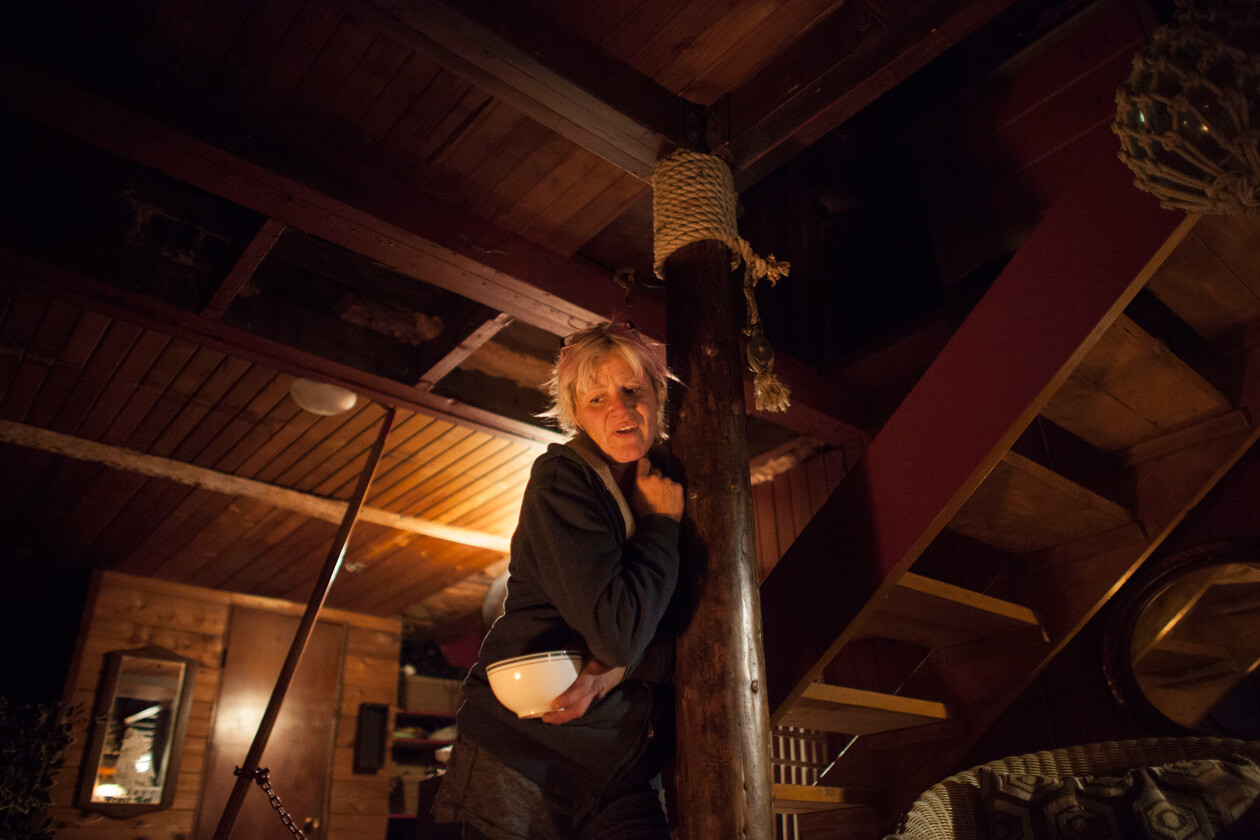
If there’s a sheriff in the Dogpatch, it’s Traci Pritchard. She is forty-seven years old, bears a passing resemblance to Pamela Anderson, and has muscular upper arms and a husky laugh. “It was pretty sketchy,” she says about her early years in the Patch. “A lot of partying in the evening and drugs. I decided I had had enough when someone broke into my boat. I took care of everything after that.” Traci says she has often jeopardized her safety by trying to bring order to the Patch. On the inside of her shallow pink skiff is a warning: “Beware the dogs; they eat everything I shoot.” Many in the Patch try to avoid confrontation, but Pritchard will approach anyone who disturbs the calm. This has resulted in nose-to-nose shouting matches, brandished flare guns, restraining orders, cut lines, missing equipment, and whispers about who’s responsible for what crime.
It’s not easy being one of the few women in the male-dominated Dogpatch, but Pritchard went through a hazing process before earning her spot as the de facto authority figure: “The guys here would pull tricks on me, pull my anchor, and I’d wake up and be on the shore. They ran the other girl outta here, but eight years later, I’m still here.” (There are two other women living in the Patch. One is a recluse who rarely comes out of her boat, and the other is a new arrival who declined an interview.)
In her nearly fifty years on Vancouver Island, Pritchard has lived many lives. She was married for eleven years and has two adult daughters. “I was very transient after my divorce,” she says. She moved from shelter to shelter, struggling with alcohol and drugs and the lingering trauma of a past assault. When she describes the details of how a Nanaimo man stalked her for two years before confining and beating her, her eyes lock on some distant point.
In 2009, the port authority in Nanaimo—twenty-five kilometres north on the Trans-Canada Highway—instituted insurance fees in the harbour where Pritchard lived. The owner of the boat she rented pulled it from the water and, suddenly, Pritchard was homeless. Still, she wanted to live on the water. “I found it kept me moving,” she says. On a trip to Victoria, Pritchard bought her own boat for a dollar and christened it Plan B. The owner had planned to ditch it in the Patch, and that’s how Pritchard wound up here.
“I wore my snowsuit to sleep, had no heat, no nothing,” she says. She refurbished and resold Plan B, bought another boat, fixed that one up, and resold it for the most cash she had ever held in her hands, $4,500. That became the down payment on her current home: a 2,000-square-foot floating shingled cottage that she calls Anchor Management and that she says she’ll die on.
Recently, after the LMS installed a floating log barrier between properties that forced Dogpatchers to motor their skiffs farther into the channel if they wanted to reach the docks, Pritchard decided to build a dock for the Dogpatch. No one offered to help. Eventually, she abandoned the project on the beach. “I accord her as much space as she desires,” says Bryan Livingstone, a long-time Patcher. “I would not want to get into a fight with her, because she’d win, hands down.” Others are less sanguine about the arrangement; they resent how Pritchard careens forward, consulting no one.
There are many splintered relationships like these in the Patch. Hardly anyone is universally liked, and alcohol is the most polarizing of vices here. The sober Patchers—whether they be recovering alcoholics or long-time abstainers—are isolated from a core group of rowdy drinkers. There are long-standing feuds that have grown out of perceived slights, neighbours who never speak, on-again, off-again friendships. Everyone seems to have a bit of gossip on everyone else.
But many also tell stories of saving someone or being saved. On land, you might walk past someone passed out on the sidewalk, but on water, the unwritten law of the sea demands that you help someone in need. Pritchard can count eight people she’s rescued over her time in the Patch. Once, she opened her front door to see the bow of a boat flush against her dock. An elderly couple couldn’t haul up their anchor and had drifted right into Anchor Management. Pritchard spent an hour pulling the heavy, slippery chain from the depths. A few years ago, she had a heart attack, and a former wharfinger at the LMS docks heard her calling for help. He drove her to the hospital, and, in her delirium, she called him dad.
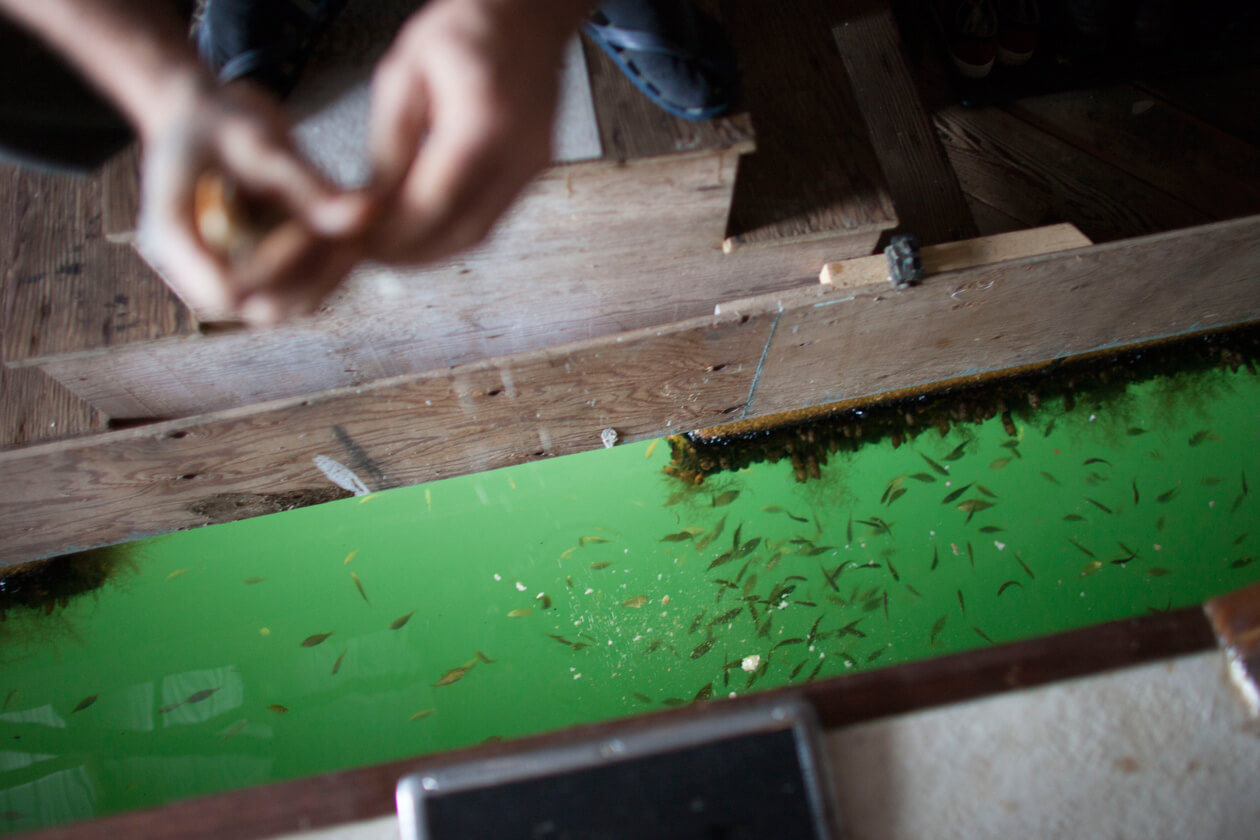
In November, a month after the eviction notices went out, Pritchard was down to her last article of clean clothing: bright-purple pyjamas patterned with bug-eyed, neon-green frogs. She tucked them into a pair of gaping rubber boots and dragged a basket of colourful clothing along the LMS docks. “I so had no clean clothes,” she says with a laugh. Many people in the Patch shower, fill up water tanks, and use the laundry machines at the marina, but the Dogpatch and the LMS remain uneasy neighbours. While some Patchers wage a never-ending battle with the wealthier LMS—over the floating log line, for example—Pritchard has become their most active volunteer. She processes all the recycling in a special boathouse crammed with bottles and a wheelbarrow. During the summer, she volunteers as a boat greeter. Each slip has a planter that Pritchard and other volunteers decorated with fake flowers, old perfume bottles, driftwood, and other finds from beach-combing excursions. “I’m constantly moving, here,” she says. The momentum of living on pitching, heaving water propels her forward as she shifts from one task to the next and the next. She has sea legs that shake when she’s back on solid land for too long.
In the Patch, a fairly routine chore such as laundry multiplies into myriad steps: piloting a dinghy around the LMS breakwaters, hoisting baskets of clothing over the gunnel and onto the dock, calculating the right moment to step from swaying deck to swaying dock. This backdrop of danger and necessity breeds an intense focus on the task at hand.
Aside from in the summertime, there is no traffic here. The tides ebb and flow two times a day, pirouetting boats around their anchors. Every morning, Inkersell sprinkles oat flakes into the water for the minnows beneath Sojourn—his “aquarium,” he says. The resident seal is like a neighbourhood dog, following people as they row back and forth to their boats. A family of otters moves as one wriggling mass. They are the raccoons of the Patch, crawling into dinghies, eating everything, shitting everywhere. When Pritchard hears the sweep and flap of a blue heron passing her window, she peels back the curtain and sees a dinghy approaching her dock. The herons are good watchdogs.
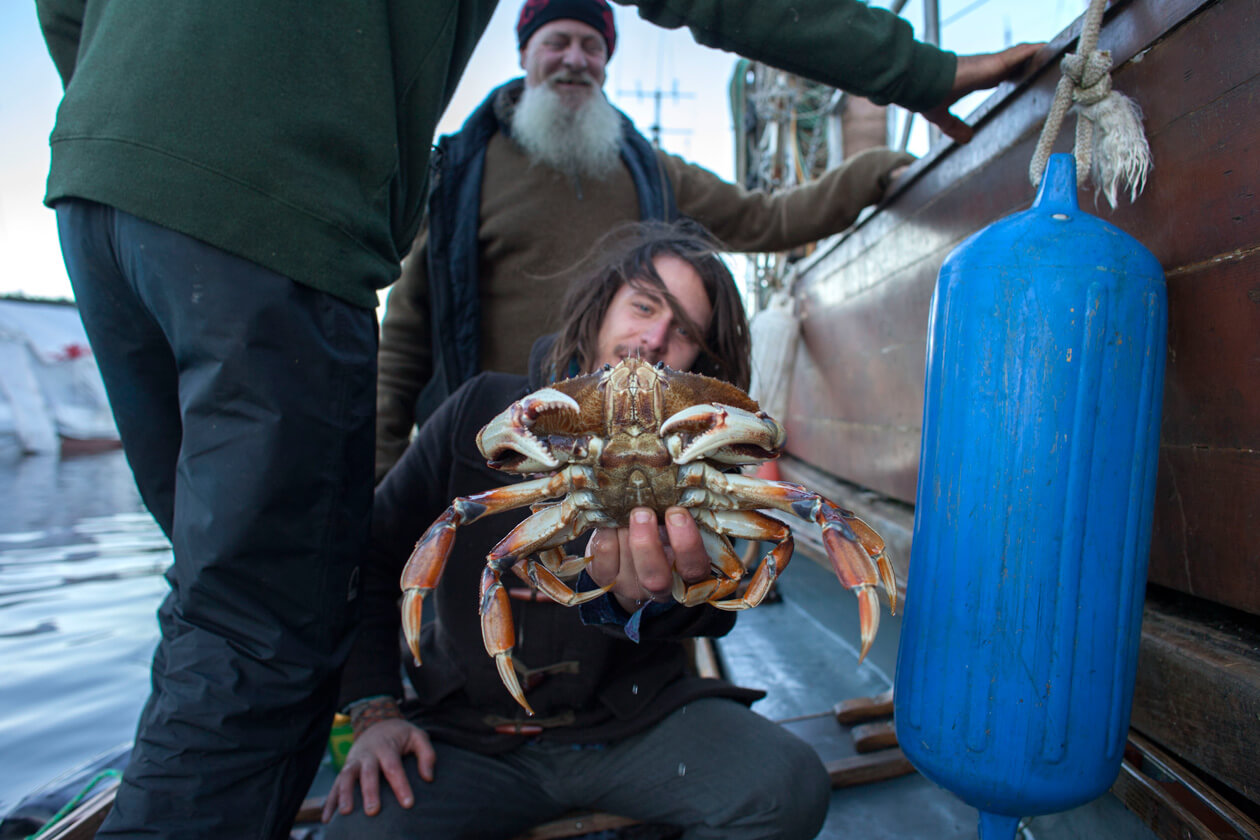
The interiors of Viki Lyne II are splattered with pigeon shit and rust. Underfoot, you’ll find broken glass, empty pop bottles, bent nails, and soft moss that’s sprouted up between the wooden planks. Roosting birds flutter toward a hole in the roof at the sound of footsteps in the wheelhouse. Inkersell, who lives next to the trawler, goes on board regularly to secure her ropes before a storm — and to shop. The Patch’s scourge doubles as its hardware store. He finds sheets of Plexiglas and spools of rope to use on Sojourn. Once, he crossed paths with someone carting out a barrel of steel scraps to use for an anchor.
No one is impressed if you pay for something new in the Patch, but if you find it and jerry-rig a solution—that’s a story. The dumpsters at the end of the LMS docks act as an informal trading post. One day in November, a composting toilet sat there for only a few hours before disappearing. Norman Brook, a former Patcher who now lives at the LMS docks, was telling Dogpatcher Lew McArel about a TV he dropped off at the dumpster. “Oh, I picked that up,” McArel said, but he hadn’t been able to find the remote control. Brook handed it over.
A few Patchers track where the town’s restaurants off-load their goods at the end of the day. These dumpster divers who haul back wood pallets to use for their stoves jokingly refer to themselves as “freegans.” The Ladysmith Health Care Auxiliary Thrift Shop on First Avenue is their store of choice. McArel has no problem wearing women’s jeans so long as the zipper is long enough. “We in the Patch are not the contaminators,” says Bryan Livingstone. “We are living on the leftovers, the discards. We have, ecologically, a very small footprint.”
Everyone in the Patch has a half-finished project: Inkersell labours over his engine, McArel fixes a mountain bike in the rain, Pritchard taught herself how to repair a generator. “Part of the reason I bought this boat is not only to refurbish it, but to develop myself as well,” Inkersell says. “Experience, the way I see it, is knowledge. When I’m fifty, I don’t wanna be this guy who doesn’t have much life experience and is in this shitty job.”
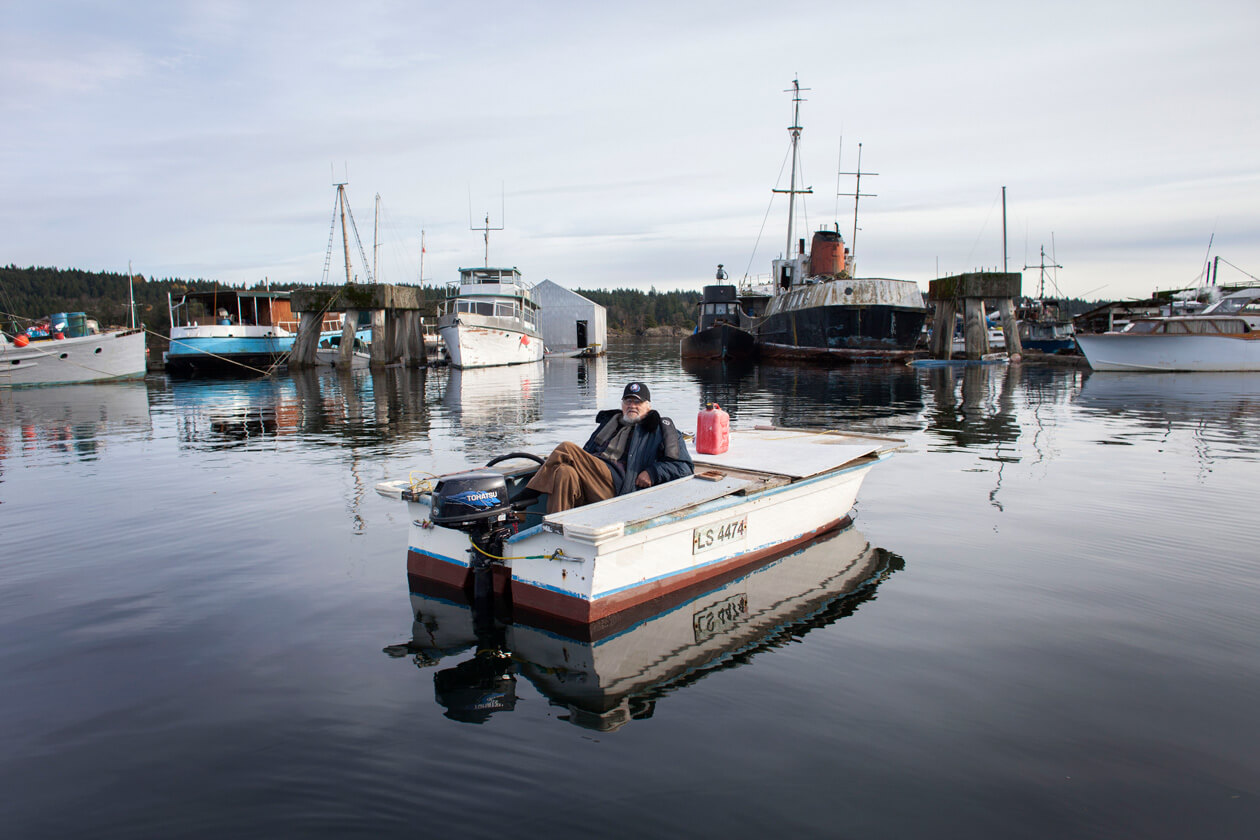
On November 12, three days before the town was expected to remove the boats, Inkersell spoke anxiously into his new cellphone. “Can we get a confirmation or a statement that, come November 15, no further action will be taken?” he asked. He was on the line with Ruth Malli, Ladysmith’s city manager. After Inkersell mailed the petition, Malli and the mayor invited him to an informal meeting in which the two sides agreed to work together. Although the town couldn’t guarantee it wouldn’t remove boats on November 15, Inkersell left the meeting feeling optimistic.
Days passed, then a week, and he heard nothing. He says his calls and emails to Malli and the mayor went unreturned. (Malli says she always called him back.) He stopped by town hall; he was told neither of them was there. The night of November 11, the first storm of the season screeched into town. On a boat, there are many noises: creaks, moans, slaps, slams. Eventually, you learn to tune out the everyday din. Around 4 a.m., Inkersell woke to an unfamiliar bang.
He climbed out of his warm berth and slipped on his flip-flops. Outside, rain flew in sharp horizontal blasts, and waves crashed in from the southeast. Inkersell discovered that one of the car tires that protected his boathouse from rubbing against the cedar dock had been mushed into a flat strip of rubber. One big wave would raise her up and slam her down, and might crack the boathouse clean through. In the dark, Pritchard passed by in a skiff, shining a flashlight and checking boat lines. Waiting for a break in the waves, Inkersell squeezed a new tire between the dock and his home.
That day, Inkersell spoke with Malli for five minutes. She needed other jurisdictions to approve an extension of the deadline, and she didn’t have their go-ahead, she explained. “She said people are still expected to move by November 15, and has anyone done that?” Inkersell said after he hung up. “I said, ‘No, people are fearing the ocean more than your eviction.’” He rubbed his eyes, hunched over the table in his galley. There wasn’t enough time to find a new place to anchor, to pack up the boathouse — with the generator, smokehouse, skiff, and floating docks—and haul it all away. And what if he left, and the town decided to work with the people who didn’t? He didn’t have a choice but to stay.
“I better not get fucking arrested for this,” he said.
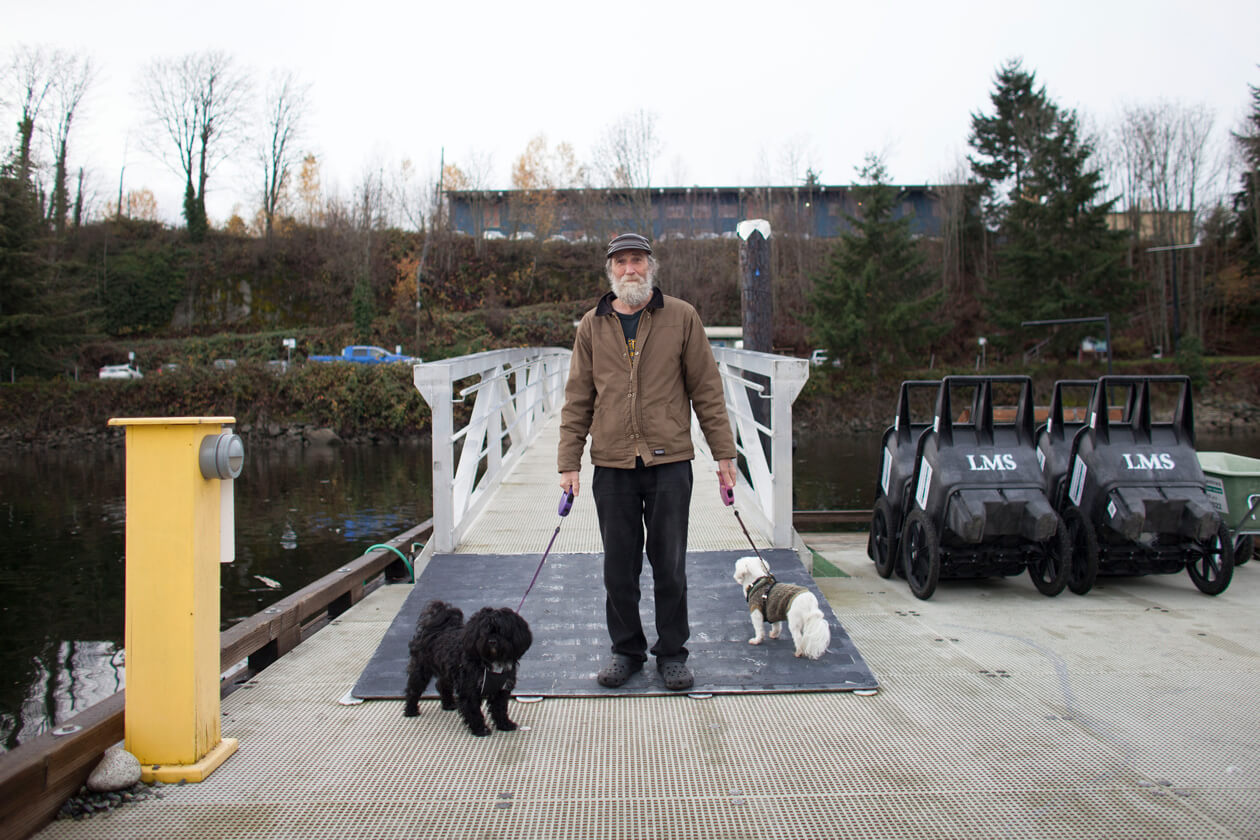
Sometimes, Pritchard thinks of moving Anchor Management out of the Patch altogether, leaving behind the pollution, the in-fighting, the endless scramble to survive. “Living here takes a toll,” she says, looking at a picture that shows her when she first arrived, smiling her dimpled grin, a less weathered version of herself. There’s a reason most in the Patch are healthy, able-bodied men.
But, eventually, bodies break down, driving even the diehards away. Norman Brook has lived at anchor most of his adult life, including two and a half years in the Dogpatch. He is fifty-eight years old, but looks older, with a long white beard, sun-worn skin, and friendly hazel eyes. He has suffered from chronic pain and headaches since he was injured while serving in the navy in 1978. His wife has fibromyalgia.
Four years ago, Brook received a settlement from Veterans Affairs Canada, and the couple moved into a slip at the Ladysmith Maritime Society, where it costs him $620 a month to park. The Patch routine of cutting up wood for warmth, of motoring back and forth to land to walk their two dogs, had become too much for them. But still, they visit the Patch often, and, if their health permitted, they would choose anchoring there over the safety of a public dock. “The only real security of person I have ever felt is living at anchor,” Brook says.
“I hate getting old,” Lew McArel says bitterly. If the town evicts him on November 15, he’ll have nowhere to go. “Go where?” he says. “I’ll just live on the streets.” Others seem just as dependent on the Patch as McArel. There’s an eighty-something deaf mariner who lives on a strung-together collection of boats powered by a booming generator, and a couple of hoarders getting by on disability cheques. Packing up a subsistence lifestyle is a challenge in itself. But where do you move when your way of life is impossible everywhere else?
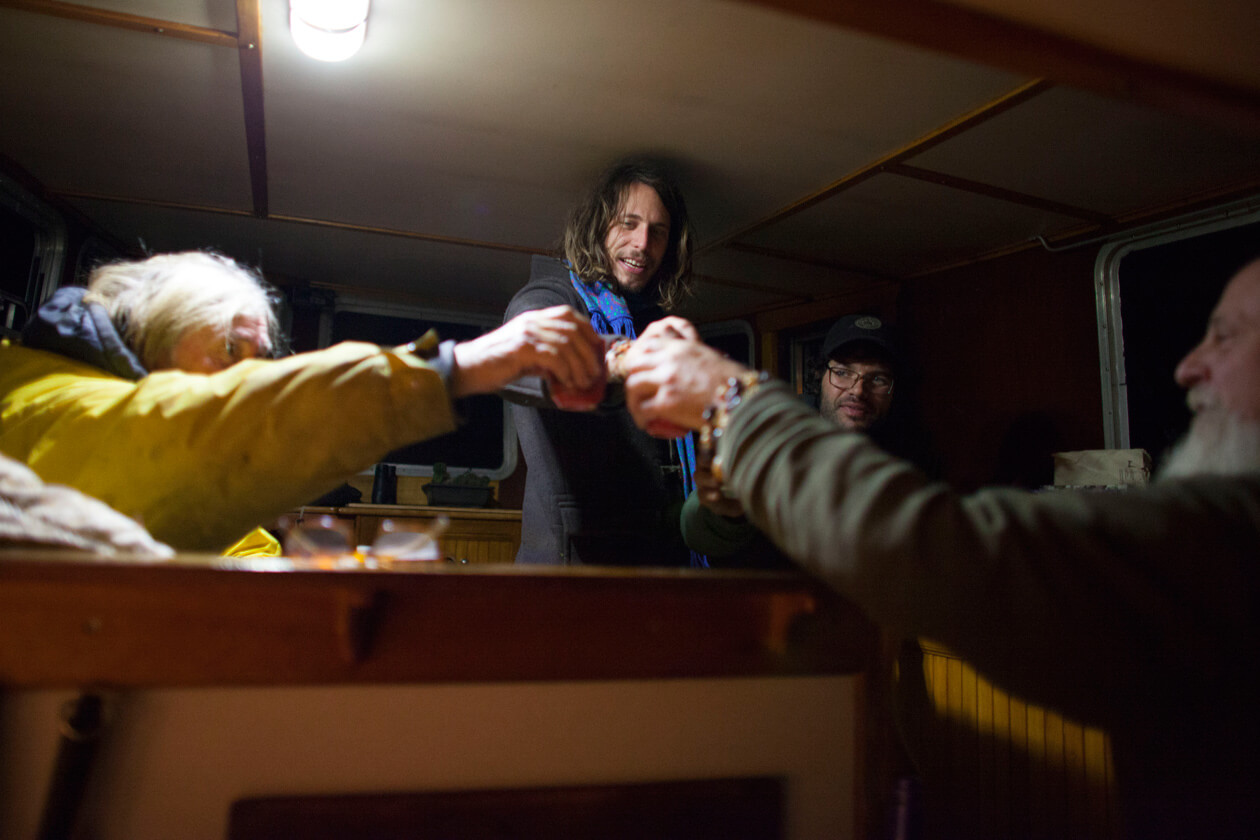
On November 15, the Dogpatch was at maximum capacity: every owner with a boat was there, waiting. It was grey and cold, a shiver of rain sprinkling the water. As eviction day progressed, the sun broke weakly through the clouds. A convivial feeling crept up. For once, everyone was in the Dogpatch for the same reason. People who hadn’t shown their faces in months were on deck, sipping beers and watching for the town’s next move.
Inkersell spent most of the day fiddling with Sojourn’s rebuilt engine. That’s how he used to spend his time before the bylaw officer motored up and he became an unlikely spokesperson for an unexpected movement. Inkersell had given up his time, his privacy, and his plans, and, in the end, those sacrifices didn’t seem to have protected his boat or anyone else’s. He squirted more oil into the engine and got back to work.
Throughout the day, a man went through the Patch dropping off envelopes with the words “Fight the Eviction” scrawled on the front. When he came to Pritchard’s dock, she told him off for coming aboard without permission. Then she saw the envelope. Inside was a letter claiming that District Lot 651 belonged to a lessor that this man knew in Calgary and that the town had no right to remove their boats. The town maintains that the water lot, regardless of who owns it, is still subject to municipal zoning rules.
After hours of trial and error, Inkersell’s motor finally roared clean and loud, just as it was supposed to. Inkersell backed her out of the boathouse, keyed up and excited. As he rounded the Ladysmith harbour, one of the engines failed. He turned Sojourn around and took her limping back to the boathouse with the remaining engine. He had tugged at the tangle inside Sojourn, and, for a moment, briefly broken free.
Later in the evening, a small party gathered on Huard’s boat. That day, he had hauled up Dungeness crabs from farther out in the channel, and now he was at the barbecue, slathering them in sauce. Inkersell poled his skiff over to Huard’s boat, gondolier style. A few days earlier, the engine on Inkersell’s skiff had died as well. Until Inkersell found a cheap replacement, he’d be stuck paddling around the breakwaters to the LMS docks. A water run that had once taken five minutes now took twenty.
As Huard grilled crabs on the deck, Inkersell took a seat inside at the wooden galley. Across from him, Luke English, a newcomer to the Patch, ate a bowl of spaghetti and flipped through a book of knots. Everyone called this twenty-six-year-old long-haired tree-planting troubadour “Newbie.” He had arrived three months ago and knew nothing about boats, but the Patchers liked him all right so far. He set aside the empty bowl and strummed a few chords on his guitar. “I’m a happy noodle man,” he sang to himself. “I’m Italian.”
Outside, the sky faded from blue to pink to black. Huard flicked on his headlamp to watch the crabs turn from grey to red on the barbecue. “You stay as long as you can, and then they will kick you out. Why? ’Cause it’s the best place on the water,” Huard says. “We don’t have rights. It’s all at the whim of when the water lot is sold to someone. Then we gotta go. Meanwhile, we’re gypsies. We gather in an area, hang out together, protect each other, and then eventually we all scatter and find a new place.”
As the stars came out overhead, they were reflected in the ocean below. The party inside grew louder, voices and guitar strums ricocheting off the tight interior. The conversation swung to the November 15 deadline. No town official had shown up. Either the Dogpatch had called the town’s bluff or they were living on borrowed time.
“We’re here, aren’t we?” Inkersell said. He held up his glass. “Here’s to another seven days.” Newbie improvised a new song on the guitar. “They want to kick you out of town,” he sang in a bluesy twang. “But at least your boat hasn’t burnt down.”
Later in November, Ladysmith bylaw officer Mark Hayden stood on the shore counting the boats in District Lot 651. From his vantage point, he could see that ten vessels had complied with the infraction notice and left the coast. The remaining boat-dwellers continue to live in the Dogpatch. Town council is still focusing on removing environmentally threatening boats. Viki Lyne II remains in the Patch today.
This appeared in the July/August 2016 issue.






